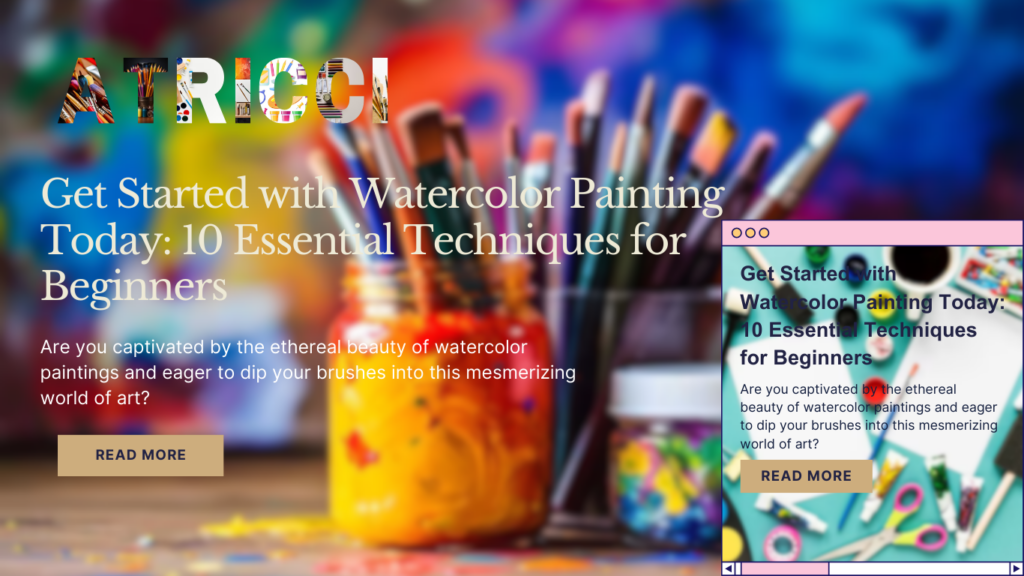No products in the cart.
Manu Verma
04/27/2024
Are you captivated by the ethereal beauty of watercolor paintings and eager to dip your brushes into this mesmerizing world of art? Look no further – Articci, your go-to destination for art supplies and classes on the Gold Coast, is here to guide you through the foundational techniques of watercolor painting. Whether you’re an aspiring artist or a hobbyist, these essential techniques will pave your path to creating stunning watercolor masterpieces. Let’s dive in!

Before embarking on your watercolor journey, acquaint yourself with the tools and materials you’ll be using:
Watercolor paints come in various forms, including pans and tubes. Start with a basic set of colors and gradually expand your palette as you gain confidence.
Invest in a variety of brushes, such as round, flat, and detail brushes. Different brushes produce different effects, allowing you to experiment with textures.
Quality matters when it comes to watercolor paper. Look for papers labeled specifically for watercolors, as they can handle the paint and water without warping.
A mixing palette is essential for creating a range of colors. A porcelain or plastic palette with wells for mixing will serve you well.
Apply a wash of water on the paper before adding diluted paint. Watch as the colors blend beautifully, creating soft gradients.
Use a drier brush and thicker paint to achieve texture and intricate details. This technique is perfect for adding fine lines or emphasizing textures.
Build up your painting by layering washes of colors. Let each layer dry before adding the next, creating depth and richness in your artwork.
Apply thin layers of transparent paint over dried layers to achieve vibrant and luminous effects. Glazing adds complexity to your colors.
If you make a mistake or want to create highlights, gently lift off the paint using a clean, damp brush or a paper towel.
Sprinkle salt on wet paint to create unique textures. As the paint dries, the salt absorbs pigment and leaves behind intriguing patterns.
Masking fluid is your ally when preserving white areas. Apply it to specific areas you want to protect, then peel it off once the paint is dry.
Master the art of transitioning colors smoothly with gradients and washes. These techniques are essential for creating skies, backgrounds, and water effects.
Paint on dry paper for controlled, crisp edges. This technique is great for adding details and intricate elements to your watercolor paintings.
Instead of painting the subject itself, paint the space around it to create a striking silhouette. By using this technique, you will be able to create artwork that has greater depth and complexity.
While watercolors offer endless possibilities, don’t hesitate to explore other mediums that can complement your artwork. Consider experimenting with oil pastel art, acrylics, irodori, acrylic mediums, and ink acrylic to broaden your artistic horizons.
At Articci, we’re passionate about nurturing artists’ growth. Join our art classes on the Gold Coast to learn directly from experienced instructors and fellow enthusiasts. We provide a supportive environment to help you flourish as an artist.
For watercolor painting, opt for a variety of brushes such as round, flat, and detail brushes. These brushes offer versatility and help you achieve different textures and effects.
Using proper watercolor paper is recommended. Regular paper might not handle the water and paint effectively, leading to warping and less desirable results.
To fix mistakes, you can gently lift off paint with a clean, damp brush or a paper towel. Another option is using masking fluid to preserve areas you want to keep white.
Pans are dry watercolors in small trays, while tubes contain wet paint. Pans are great for convenience and portability, while tubes offer more vibrant and intense colors.
You can create texture using techniques like the dry brush method, salt texture, and layering. These techniques add depth and visual interest to your artwork.
Manu Verma
04/27/2024
Manu Verma
04/23/2024
Manu Verma
04/14/2024
Manu Verma
04/09/2024